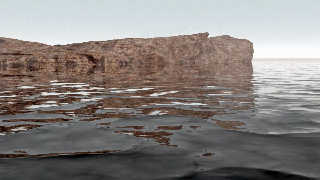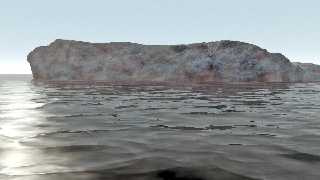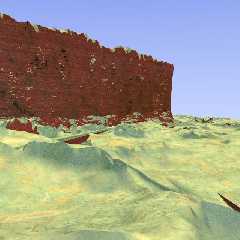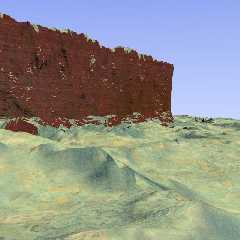 |
 |
|
 |
|
 |
|  |
|  |
|
 |
|
 |
|  |
|  |
|
 |
Hello all, I've been playing around a bit with Bill Pragnell's meshrelief.inc
macros, and seeing how they'd work for creating eroded mountains and such.
I'm trying to find something that can be a good quick-rendering stand-in for an
isosurface in a landscape. Anyway, here's the result of eroding a simple
Wings3d beveled box by iterating MeshShape() a couple of times with different
pigment deformations and high mesh resolution (almost 1 million polygons).
-Rob
Post a reply to this message
Attachments:
Download 'rwm_meshrelief_landscape1.jpg' (400 KB)
Preview of image 'rwm_meshrelief_landscape1.jpg'

|
 |
|  |
|  |
|
 |
|
 |
|  |
|  |
|
 |
These render pretty fast - just under 10 minutes for this one. This and the
previous test were rendered in MegaPov with HDRI and proceduralized rock
textures.
-Rob
Post a reply to this message
Attachments:
Download 'rwm_meshrelief_landscape2.jpg' (92 KB)
Preview of image 'rwm_meshrelief_landscape2.jpg'

|
 |
|  |
|  |
|
 |
|
 |
|  |
|  |
|
 |
"Robert McGregor" <rob### [at] mcgregorfineart com> schreef in bericht
news:web.4855e1a5c71f0eb1bd1b3ad10@news.povray.org...
> Hello all, I've been playing around a bit with Bill Pragnell's
> meshrelief.inc
> macros, and seeing how they'd work for creating eroded mountains and such.
>
> I'm trying to find something that can be a good quick-rendering stand-in
> for an
> isosurface in a landscape. Anyway, here's the result of eroding a simple
> Wings3d beveled box by iterating MeshShape() a couple of times with
> different
> pigment deformations and high mesh resolution (almost 1 million polygons).
>
Hey Robert! That is looking very good!
Seems we have been doing pretty much the same thing these last days. I have
revisited an old scene of mine (Alien Cliff) of a couple of years ago, which
consisted principally of two isosurfaces: a cliff with scree slope, and a
hardground. I used those two isosurfaces as input for the MeshShape() macro,
used a pretty high resolution (500) and got these things, after I processed
them once through Poseray in order to smooth out some too visible faces.
I am quite satisfied with the cliff and scree mesh. I am much less satisfied
with the hardground which show a number of artificial outcrops which I have
to remove one way or another. More testing is needed here.
However, overall, the isosurface shape is faithfully transformed into a
mesh, thus dramatically reducing render time.
Thomas com> schreef in bericht
news:web.4855e1a5c71f0eb1bd1b3ad10@news.povray.org...
> Hello all, I've been playing around a bit with Bill Pragnell's
> meshrelief.inc
> macros, and seeing how they'd work for creating eroded mountains and such.
>
> I'm trying to find something that can be a good quick-rendering stand-in
> for an
> isosurface in a landscape. Anyway, here's the result of eroding a simple
> Wings3d beveled box by iterating MeshShape() a couple of times with
> different
> pigment deformations and high mesh resolution (almost 1 million polygons).
>
Hey Robert! That is looking very good!
Seems we have been doing pretty much the same thing these last days. I have
revisited an old scene of mine (Alien Cliff) of a couple of years ago, which
consisted principally of two isosurfaces: a cliff with scree slope, and a
hardground. I used those two isosurfaces as input for the MeshShape() macro,
used a pretty high resolution (500) and got these things, after I processed
them once through Poseray in order to smooth out some too visible faces.
I am quite satisfied with the cliff and scree mesh. I am much less satisfied
with the hardground which show a number of artificial outcrops which I have
to remove one way or another. More testing is needed here.
However, overall, the isosurface shape is faithfully transformed into a
mesh, thus dramatically reducing render time.
Thomas
Post a reply to this message
Attachments:
Download 'IsosurfaceTest2.jpg' (83 KB)
Preview of image 'IsosurfaceTest2.jpg'

|
 |
|  |
|  |
|
 |
|
 |
|  |
|  |
|
 |
I corrected the faulty transformation from isosurface to mesh in the
hardground (case of a an inner shape sticking out of the isosurface,
misleading the MeshShape() macro).
As all normals were facing inwards, I processed the meshes in Poseray.
Through this, the mesh sizes went also from about 38 Mb to some 80 Mb each.
This image (using radiosity) rendered in 12 minutes, while the isosurfaces
would have taken several hours.
A problem remaining are the dark triangles visible in the cliff face. As far
as I have been able to judge, the normals are all oriented in the same,
outward direction and double_illuminate is used. I think this has been
discussed in the past, but I cannot remember when or where. Any suggestion?
In any case, this exercise shows how attractive Bill Pragnell's macros are
for speeding up render time by transforming isosurfaces into meshes. Also,
as far as I can judge presently, the meshes seem to simulate the isosurfaces
better than the Jaap Frank c.s. macros, but I may be wrong there. I remember
however, that a couple of years ago, I was not able to obtain as much
detail.
Any comments or suggestions are welcome of course.
Thomas
Post a reply to this message
Attachments:
Download 'IsosurfaceTest2-2.jpg' (82 KB)
Preview of image 'IsosurfaceTest2-2.jpg'

|
 |
|  |
|  |
|
 |
|
 |
|  |
|  |
|
 |
"Thomas de Groot" <t.d### [at] inter nlDOTnet> wrote:
> A problem remaining are the dark triangles visible in the cliff face. As far
> as I have been able to judge, the normals are all oriented in the same,
> outward direction and double_illuminate is used. I think this has been
> discussed in the past, but I cannot remember when or where. Any suggestion?
Probably the infamous 'shadow line artifact'.
> as far as I can judge presently, the meshes seem to simulate the isosurfaces
> better than the Jaap Frank c.s. macros, but I may be wrong there. I remember
> however, that a couple of years ago, I was not able to obtain as much
> detail.
Those macros were more complete, and would successfully convert any isosurface.
My macros will only work properly if the centre-point and inner shape
combination can 'see' the entire outer surface. However, for my purposes (as
mentioned previously, boulders, bricks and other simple building shapes), I
think this technique does produce better meshes more quickly.
It's interesting to see the macros applied in this way - I never intended them
to be used for complete landscapes. I think better results would be obtained
for outcrops, boulders or other discrete objects that can be automatically
placed, as a supplement to heightfields or regular isosurfaces.
Encouraging though!
Bill nlDOTnet> wrote:
> A problem remaining are the dark triangles visible in the cliff face. As far
> as I have been able to judge, the normals are all oriented in the same,
> outward direction and double_illuminate is used. I think this has been
> discussed in the past, but I cannot remember when or where. Any suggestion?
Probably the infamous 'shadow line artifact'.
> as far as I can judge presently, the meshes seem to simulate the isosurfaces
> better than the Jaap Frank c.s. macros, but I may be wrong there. I remember
> however, that a couple of years ago, I was not able to obtain as much
> detail.
Those macros were more complete, and would successfully convert any isosurface.
My macros will only work properly if the centre-point and inner shape
combination can 'see' the entire outer surface. However, for my purposes (as
mentioned previously, boulders, bricks and other simple building shapes), I
think this technique does produce better meshes more quickly.
It's interesting to see the macros applied in this way - I never intended them
to be used for complete landscapes. I think better results would be obtained
for outcrops, boulders or other discrete objects that can be automatically
placed, as a supplement to heightfields or regular isosurfaces.
Encouraging though!
Bill
Post a reply to this message
|
 |
|  |
|  |
|
 |
|
 |
|  |
|  |
|
 |
"Bill Pragnell" <bil### [at] hotmail com> schreef in bericht
news:web.4857977d34131bc7731f01d10@news.povray.org...
>
> Those macros were more complete, and would successfully convert any
> isosurface.
> My macros will only work properly if the centre-point and inner shape
> combination can 'see' the entire outer surface. However, for my purposes
> (as
> mentioned previously, boulders, bricks and other simple building shapes),
> I
> think this technique does produce better meshes more quickly.
Yes, I shall have to revisit the Tor Olav Kristensen version of those macros
and apply them again to these same isosurfaces to see if this time, I can do
better, and if the results are "better" than with your macros. :-)
>
> It's interesting to see the macros applied in this way - I never intended
> them
> to be used for complete landscapes. I think better results would be
> obtained
> for outcrops, boulders or other discrete objects that can be automatically
> placed, as a supplement to heightfields or regular isosurfaces.
Well, you know how it goes! People always want to apply things to other
features, just to see if they work. :-) I agree with you however that it
would probably be better to stay within the given boundaries... but
experimenting is too tempting.
>
> Encouraging though!
It really is, and so possibilities are increased.
Thomas com> schreef in bericht
news:web.4857977d34131bc7731f01d10@news.povray.org...
>
> Those macros were more complete, and would successfully convert any
> isosurface.
> My macros will only work properly if the centre-point and inner shape
> combination can 'see' the entire outer surface. However, for my purposes
> (as
> mentioned previously, boulders, bricks and other simple building shapes),
> I
> think this technique does produce better meshes more quickly.
Yes, I shall have to revisit the Tor Olav Kristensen version of those macros
and apply them again to these same isosurfaces to see if this time, I can do
better, and if the results are "better" than with your macros. :-)
>
> It's interesting to see the macros applied in this way - I never intended
> them
> to be used for complete landscapes. I think better results would be
> obtained
> for outcrops, boulders or other discrete objects that can be automatically
> placed, as a supplement to heightfields or regular isosurfaces.
Well, you know how it goes! People always want to apply things to other
features, just to see if they work. :-) I agree with you however that it
would probably be better to stay within the given boundaries... but
experimenting is too tempting.
>
> Encouraging though!
It really is, and so possibilities are increased.
Thomas
Post a reply to this message
|
 |
|  |
|  |
|
 |
|
 |
|  |
|
 |




![]()